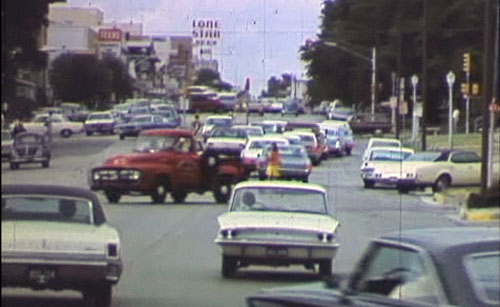TAMI Flashback: A Trio of TEA

This article is the fourth in a Slackerwood series about the Texas Archive of the Moving Image (TAMI) video library.
While poking around in the TAMI library for videos to feature in this article, I found three very interesting bits of Austin nostalgia from an unlikely source: the Texas Education Agency (TEA), which oversees the state's public education system. These videos are great examples of vintage state agency films, with high-quality production values, beautiful soundtracks and some surprising connections to Austin's fledgling film and music industries. (Then again, given the quality of these films, maybe these connections are not so surprising.)
The New American Schoolhouse is an early 1970s look at the career and technical programs the TEA's Department of Occupational Education and Technology offered to high-school students. Shot in Austin and Ft. Worth, it spotlights examples of career education in graphic arts, health care, retail, manufacturing, data processing and other vocations. (Remember data processing? I hear it was a career with a future.) Beyond showing these examples, the film promotes the then-novel idea that to prepare students for life after graduation, their education must combine classroom and real-world learning.
Like many films from this era, The New American Schoolhouse presents the expected parade of computer -- er, data processing -- equipment the size of refrigerators, hairdos nearly as large, yacht-sized American sedans, mini-dresses, striped sport coats, and hideous pantsuits that women now swear they never wore. (Such denial is pointless; there is plenty of photographic evidence of these fashion faux pas.) The film also has pleasantly artsy, film-schoolish visuals, from sometimes unflattering close-ups of students' faces to sweeping shots of urban vistas. The opening sequence's birds-eye view of downtown Austin is fascinating, as the camera pans over St. Mary Cathedral, City National Bank, I-35, and the hills west of Austin. One interesting scene was filmed at the Austin American-Statesman.
Another highlight of The New American Schoolhouse is the mellow folkie soundtrack by Bobby Bridger. A talented singer, songwriter, poet, actor, playwright and author, Bridger arrived in Austin in 1970 and was a pillar of the local music scene until he moved to Houston in 1995. His music for The New American Schoolhouse is oh-so-very 1970s Austin, making the film feel especially nostalgic.
[View original at Texas Archive of the Moving Image.]
A more narrowly focused film is Toward a Better Tomorrow -- Independent Mobility for the Blind. Produced by the TEA in 1968, Toward a Better Tomorrow documents a summer program to help visually impaired students live independently. The program's students practiced many skills, from dressing themselves to navigating busy intersections, and also received career and personal counseling.
Toward a Better Tomorrow is notable more for its many scenes of Austin than its content, which is a mix of talking heads and explanations of how visually impaired students learn various skills. There is a great opening sequence on The Drag (pictured above); about the only thing that hasn't changed is the Texas Theater sign. (Actually, while the sign remains, the theater is now a CVS drugstore.) Other scenes were shot in a typically charming Central Austin neighborhood probably near the University of Texas, and on a very crowded Congress Avenue.
One thing I especially like about Toward a Better Tomorrow is the soundtrack, including the simple, beautiful and very nicely shot closing song, performed by a quintet of students in the program.
[View original at Texas Archive of the Moving Image.]
In a similar vein, The Blind Can Do documents another late 1960s summer program for students at the Texas School for the Blind and Visually Impaired. The program taught the students daily living and work skills and gave them hands-on training at Austin businesses.
Like Toward a Better Tomorrow, The Blind Can Do's content isn't remarkable, although it's interesting to note that much of it involves Braille, which has been replaced in many instances by book readers, accessible websites and other digital devices that assist with reading and writing. The film's most interesting aspect is that many scenes were shot at Austin businesses, including Lammes Candies and the long-gone Shoppers World. Look carefully about 17 minutes into the video to catch a glimpse of the Northwest Shopping Center at the corner of Koenig Lane and Burnet Road, as well as Allandale Village across the intersection. Sadly, most of the color has faded from the film, but it's still great fun to see so much of 1960s Austin.
If you're as crazy about Austin movies as I am, you'll no doubt share my amazement that The Blind Can Do's production crew included none other than Lou Perryman. Perryman later starred in two revered films, Eagle Pennell's triumphant The Whole Shootin' Match and Last Night at the Alamo. In a long career as a character actor, Perryman also appeared in The Blues Brothers, Poltergeist and many other films. One other interesting bit of trivia: The Blind Can Do's lush, dreamy acoustic guitar soundtrack is by Jim Schulman, who appeared in Tobe Hooper's first feature, the Austin-made Eggshells.

